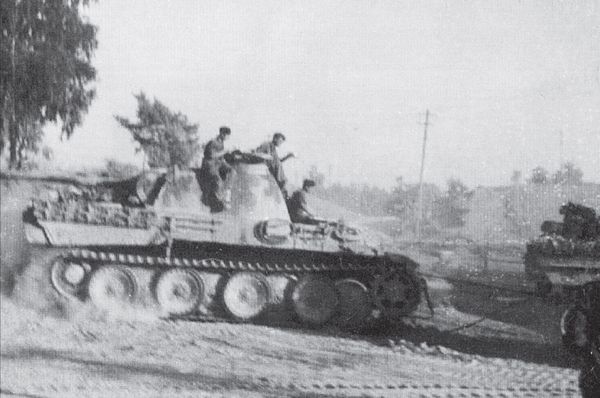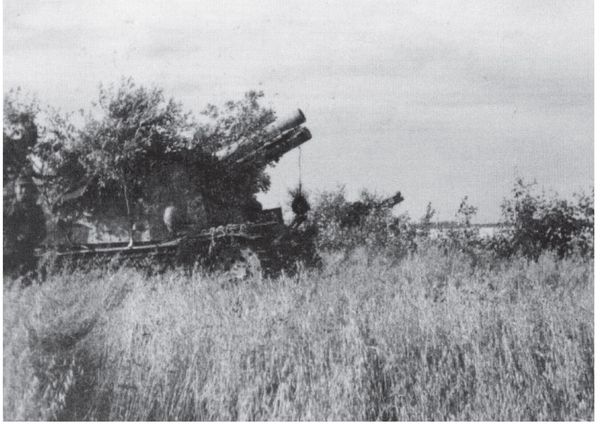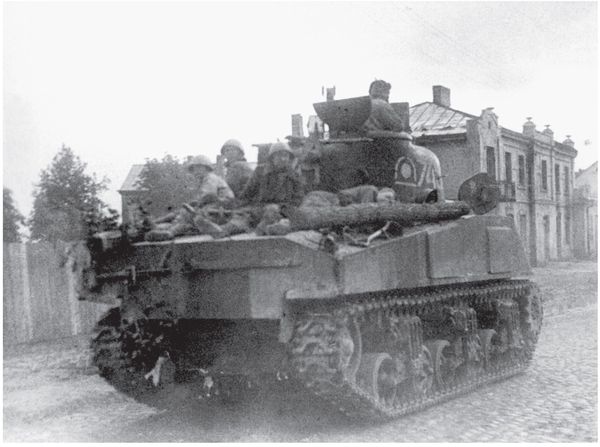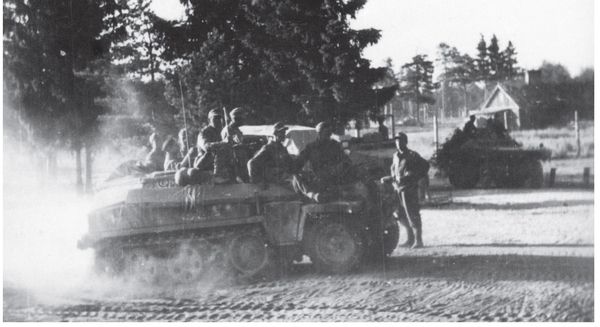Warszawa II (5 page)
Authors: Norbert Bacyk


A Panther behind the frontline, note the reversed turret. (All pictures Leandoer & Ekholm Archive)
On July 25, the 2nd Tank Army's frontline troops reached the WisÅa having taken DÄblin and PuÅawy. An attempt to cross the river failed due to the determined resistance of the 174th Ersatz-Division. While awaiting the arrival of larger infantry units, General Radzjijevskij had held a part of the 16th Armoured Corps there, but gave the 3rd Armoured Corps and the 8th Armoured Guards Corps the mission of continuing attacks along the WisÅa in a northerly direction. On July 26, Soviet tanks set off at speed towards Garwolin. Following with them was the 8th Army's Infantry Guards Corps. This was the 1st Polish Army â renamed on July 27, the 1st Polish Volunteer Army â which had the mission of manning the frontline outside DÄblin.
At the same time that the two armoured corps from 2nd Tank Army pressed on, without pause, towards Garwolin, the battle for Brest in the east was being decided. The Germans, making use of components out of the 102nd Infantry-Division and the 3rd SS-Panzer-Division “Totenkopf,” succeeded in manning Siedlce in time and General Krjukov's rapid response force's first attack on the city on July 24 was thrown back in bloody fighting. In short, the 11th Tank Corps and the 2nd Cavalry Brigade Corps got tied down in intense fighting and were not able to defeat the enemy by themselves, who had rather unexpectedly and in significant force made use of air attacks. As a result, the attackers were forced to await the arrival of the 47th Army. General Weià had been successful in holding on to Siedlce, but the situation outside Brest by the Bug River had become critical. With the Soviet 28th Army having reached the Bug River near Siemiatycze, the city's garrison â the XX and the VIII Army Corps â was now under threat of encirclement. Sometime on or about July 23, the commander of the 2nd Army ordered both corps to leave the city, and in all haste make towards Siedlce and SokoÅów (at this time, the VIII Army-Corps was about to be split up: both units were actually already under the command of the XX Army-Corps' staff). A consequence of this sizable German retreat towards the west was that it worked to enhance the German troop strength protecting the Siedlce road. Brest itself was defended by the weakened Tactical Group “E” under the command of General Felzmann. This group had been built up from the bones of 203rd Sicherungs-Division.
A battery of tracked vehicle howitzers 15 cm sIG 33/1 auf Fgst PzKpfw 38 (t) Ausf. H “Grille” from Panzer-Grenadier-Regiment 12, 4th Panzer-Division, Eastern Front 1944. (MWP)

The Commandant for the installation was General Scheller.
On July 25, immediately following the XX Army-Corps' retreat, the 20th Rifle Corps, from the 28th Army under General Sjvarjev, attacked Brest from the north, while the 9th Rifle Guards Corps under General Khaluzin from the 61st Army attacked from the east, and the 114th Rifle Corps under General Rjabysjev from the 70th Army attacked from the south. Prior to July 27, the German defenders of the city were surrounded and cut off from the rest of the 2nd Army. During the night of July 27, General Felzmann gave the order to breakthrough towards the west. As a result, the Soviet units on the following morning were able occupy the abandoned city of Brest and, at the same time, encircle the fleeing Tactical Unit “E'” yet again, about ten kilometres east of Janów Podlaski. Given the prospect of General Felzmann's entire force being annihilated, a rescue operation was carried out and an improvised Kampfgruppe from the 102nd Infantry-Division was sent in, strengthened by a number of companies from the 5th SS-Panzer-Division “Wiking.” Despite this, the Germans came to suffer considerable losses during the retreat and lose nearly all of their heavy battlefield equipment. General Scheller, among others, was captured.
A Soviet M4A2 “Sherman” from the 8th Tank Guards Corps, in Lublin, July 1944. (RGAKFD)


An artillery gun, model ZiS-3, and Soviet infantry during fighting in Lublin, July 1944. (WAF)
At the same time, on July 28, after the battle for Brest had ebbed out and while intensive fighting for Siedlce raged on; STAVKA issued new orders to Marshal Rokossowski. Order nr. 220162 read as follows:
“After the seizure of Brest and Siedlce the attacks on the front's right flank are to be expanded in the direction of Warsaw and the mission is to, no later than the 5th â 8th of August, seize Praga and occupy the bridge emplacement on the Narew's western bank in the area around PuÅtusk and Serock.
On the front's left flank, the bridge emplacement on the WisÅa's western bank is to be seized in the area around DÄblin-ZwoleÅ-Solec. The seized bridge emplacements shall be used for attacking in a north-westerly direction and thereby neutralise the enemy's resistance along the Narew and WisÅa and thus guarantee the successful crossing of the Narew by the 2nd Belorussian Front's left flank and likewise over the Wisla by those armies which are concentrated at the front's central section. Thereafter, attacks shall be planned in the direction of Torún and Åódź.”
Given the situation which had arisen at the front during the last days of July, this was not an especially precise and/or logical order. Rokossovskij wanted to annihilate the 2nd Army sooner, namely, east of the WisÅa's central area, and the order to attack Warsaw with the right flank (the 28th Army) and, at the same time, seize the bridge emplacements along the Narew (the 48th and 65th Armies) sapped his enthusiasm. But as though this were not enough, in a couple of additional coded telegrams from Headquarters, he was ordered to withdraw from the front, and to send the 61st and 62nd Armies north. The headquarter staff of the 1st Belorussian Front sharply objected, not only to the suggested direction the attack would be launched in, but also from the perspective of having just these two particular Armies designated to carry out this order. Marshal Rokossovskij's reasoning held that if two entire infantry armies were taken from him, his front would be dangerously weakened. In addition, the 2nd Tank Army's left flank could not cross over the Wicca south of Warsaw as there was a shortage of transport possibilities for the tanks.
Tanks of model PzKpfw V “Panther” from SS-Panzer-Regiment 5 “Wiking”; a transport vehicle Sd Kfz 251 and a Schwimmwagen (amphibious vehicle) from SS-Panzergrenadier-Regiment 9 “Germania”, July 1944.

In this situation, Marshal Zjukov, who was responsible for co-ordinating operations between the 1st Belorussian Front and the 1st Ukrainian Front, carried out a number of medium-scale changes in the original order while still retaining its main intent. Firstly, the 70th Army would remain under the existing command structure. To the north, with respect to the planned new offensive against Latvia, only the 61st Army was sent. Secondly, the 2nd Tank Army was to continue on towards Warsaw, particularly looking to send its armoured corps against the rearguard of the German 2nd Army. On having reached the join of the Bug and Narew rivers, they would then operate as the western jaw of a pincer movement. Praga would be stormed, providing it was clear that the enemy's defences were sufficiently weak. If the Germans managed to reinforce that part of the capital city with a larger numbers of troops, Radzjijevskij should await infantry reinforcements from the 47th Army. The most vital import of the directive from July 28 thus remained unchanged. The primary mission of the 1st Belorussian Front was to seize the two operational bridges north and south of Poland's capital. It was exactly from this location that the coming offensives should be launched; offensives that would ultimately destroy the German defence along the WisÅa and Narew rivers.

The “Valentine” Mk IX from the 2nd Tank Army in Poland, July 1944. (RGAKFD)
The picture depicts an Sd Kfz 250/1 Neu from Aufklärungs.Abteilung 4. 4th Panzer-Division, on the move east of Warsaw in July 1944. (Leandoer & Ekholm Archive)
